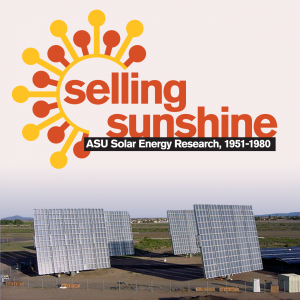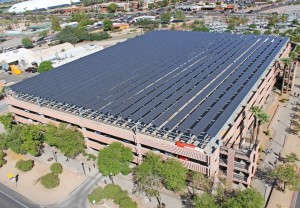January 21, 2014
 In the fall of 2013, ASU Libraries hosted the exhibit Selling Sunshine, which showcased early solar energy research and steps made to solidify Arizona as a national player in solar energy development. The materials in the Selling Sunshine exhibit included technical papers, early reports, photographs, drawings, and much more. The exhibit inspired a conversation about the history of solar energy research and development at ASU and was recorded by ASU Libraries as a featured podcast.
In the fall of 2013, ASU Libraries hosted the exhibit Selling Sunshine, which showcased early solar energy research and steps made to solidify Arizona as a national player in solar energy development. The materials in the Selling Sunshine exhibit included technical papers, early reports, photographs, drawings, and much more. The exhibit inspired a conversation about the history of solar energy research and development at ASU and was recorded by ASU Libraries as a featured podcast.
The podcast was hosted by Fred Mcllvain and University Archivist Rob Spindler, who spoke with Dr. Charles Backus, a national pioneer in photovoltaics research at ASU in the 1970’s, and Dr. Harvey Bryan, an ASU Professor of Design and Senior Sustainability Scientist. The conversation first started with the beginnings of solar energy research at ASU. Backus made note of an ASU course on direct energy conversion which began in 1968, just 10 years after ASU became an official state university. Backus taught the course for over 16 years to students from all over the country. He believes that the national visibility and steady stream of students enrolling in this course attributed to the public associating advanced energy with Arizona State University. Bryan also discussed early solar energy research at ASU by noting the contributions of ASU Professor Jeffrey Cook and Professor John Yellot. Bryan noted that Yellott contributed pioneering work in the field particularly in active solar thermal systems. He explained that Yellot began by opening a solar consulting company, Yellot’s Solar Laboratories, and ran informal classes on solar energy to interested ASU students. These informal classes were not redeemable for credit but Bryan believes it was a great educational experience from a notable ASU professor. Yellot would go on to become the first Chairman of the ASME Solar Energy Applications Group and head of Arizona State's College of Architecture solar program. He continued to teach at ASU until his retirement at age 70.
 The first solar photovoltaic testing laboratory in the United States was established in the 1990s at Arizona State University. Backus reflected on the progress that ASU has made since its establishment to present day. He believes that ASU’s Solar Power Lab has made significant strides, particularly in the national community for their knowledge of how to incorporate solar at the university, examine what the problems are, and reveal what we need to be concerned about for the future. Backus believes that solar power research and development at ASU has only become more broad-based since President Michael Crow came to the university in 2002. He believes that President Crow has done an amazing job in the last 10 years and has made solar energy more of an important issue than previous university presidents. An example of ASU’s accomplishments in solar energy is the growing number of solar power installations on campus. ASU saw its first large solar installation in 2004 when the university placed a 34-killowat project on the top deck of the Tyler Street Parking structure. According to ASU’s solar website, “the energy generated by this system provided more than enough electricity to power the structures daytime lighting and shade 44 parking spaces.” This is in part of the university’s Campus Solarization program which aims to implement solar power on all ASU campuses while also teaching students about its positive environmental impact.
The first solar photovoltaic testing laboratory in the United States was established in the 1990s at Arizona State University. Backus reflected on the progress that ASU has made since its establishment to present day. He believes that ASU’s Solar Power Lab has made significant strides, particularly in the national community for their knowledge of how to incorporate solar at the university, examine what the problems are, and reveal what we need to be concerned about for the future. Backus believes that solar power research and development at ASU has only become more broad-based since President Michael Crow came to the university in 2002. He believes that President Crow has done an amazing job in the last 10 years and has made solar energy more of an important issue than previous university presidents. An example of ASU’s accomplishments in solar energy is the growing number of solar power installations on campus. ASU saw its first large solar installation in 2004 when the university placed a 34-killowat project on the top deck of the Tyler Street Parking structure. According to ASU’s solar website, “the energy generated by this system provided more than enough electricity to power the structures daytime lighting and shade 44 parking spaces.” This is in part of the university’s Campus Solarization program which aims to implement solar power on all ASU campuses while also teaching students about its positive environmental impact.
Most recently in November 2013, ASU achieved another solar milestone by reaching a total of 23.5 MW of solar-energy capacity, which provides more than 40 million kilowatt hours annually. This amount of clean and renewable solar energy is enough to power more than 3,500 Arizona homes for one year and reduces the university’s carbon footprint by 8.7 percent. Arizona State University’s solar portfolio is currently the largest of any university in the United States. That being said, solar energy is not just a thing of history at ASU; it is the way of our future. To see real-time tracking information of ASU’s current solar energy production, visit the Campus Metabolism website.
Written by Gabrielle Olson, ASU LightWorks
Photo retrieved from ASU Solar website

